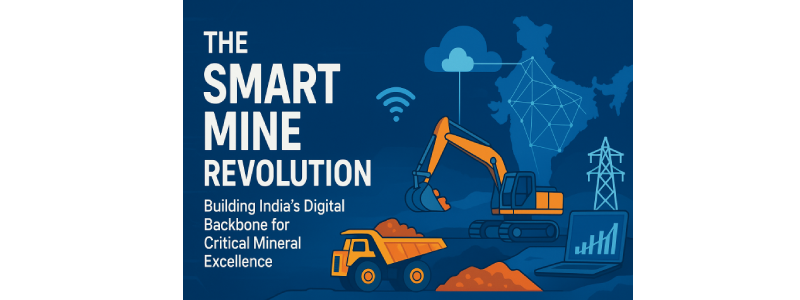
India’s Mining Transformation Begins
India stands at the brink of a new mining era – one defined not by the dust and drills of the past, but by data, automation, and sustainability. As the country accelerates toward its renewable energy goals and seeks to secure a strong position in global supply chains, mining is emerging as a strategic pillar of national progress.
In the past three years, the Geological Survey of India (GSI) has launched over 368 exploration projects focused on critical minerals – the essential elements that power solar panels, electric vehicles (EVs), smartphones, and defense technologies. This shift represents a monumental step in India’s mission to build a resilient, self-reliant, and technologically advanced mineral economy.
But the transformation runs deeper than exploration. Today’s mining operations are driven by artificial intelligence (AI), smart sensors, autonomous machinery, and real-time data analytics. Together, they are redefining how India mines, manages, and monitors its mineral wealth – creating safer, smarter, and more sustainable mines that fuel the clean energy transition.
Why Critical Minerals Matter for India
India has identified 30 critical minerals that are indispensable for its renewable energy andindustrial ambitions. These include cobalt, lithium, rare earth elements, titanium, and copper -materials that form the backbone of modern technologies.
For instance:
With India targeting 500 GW of renewable energy capacity by 2030, securing a steady, ethical, and sustainable supply of these minerals has become a national priority. To support this vision,the government has introduced new incentives and frameworks to encourage domestic exploration, private investment, and technology-led mining innovation.
Building Smart and Sustainable Mining Infrastructure

1. Real-Time Monitoring with Smart Sensors
loT-enabled sensors connected via 4G and emerging 5G networks allow mining operations tocontinuously track equipment health, vehicle movement, and environmental parameters. Thisconstant flow of data helps identify inefficiencies, reduce downtime, and optimize production.
For example, smart sensors in haul trucks can monitor load distribution and tire pressure in realtime, preventing costly breakdowns and ensuring fuel efficiency. Such systems transformtraditional mining into a data-driven ecosystem that values precision over volume.
2. Predictive Maintenance and Safety
By analyzing live sensor data, AI algorithms can predict when machines are likely to fail – allowing for preventive maintenance rather than reactive repairs. This shift reduces equipment downtime, enhances worker safety, and extends the lifespan of expensive machinery.
3. Government Support and Policy Reforms
The Indian government’s push for “Digital Mines” underlines its intent to modernize the sector. Through financial incentives, new exploration licenses, and initiatives like the National Critical Minerals Mission, policymakers are supporting not just mining activity but also research facilities, skill development centers, and innovation hubs.
This ecosystem-based approach ensures that mining transformation is inclusive – empowering local communities, fostering innovation, and attracting global collaboration.
4. Private Sector Innovation and Collaboration
Private mining companies and start-ups are investing heavily in R&D, automation, and data integration. Collaborations with technology providers and academic institutions are accelerating pilot projects and translating innovations into large-scale solutions tailored to India’s geological and operational realities.
Making Mining Safer Through Technology
Safety has always been a cornerstone of responsible mining – and digital transformation is now its strongest ally.
Autonomous vehicles, drones, and wearable sensors are being used to minimize human exposure to high-risk areas. Drones conduct aerial surveys and monitor pit stability, while wearable devices track worker vitals and detect fatigue or exposure to harmful gases.
Proximity detection systems prevent accidents by automatically stopping equipment if a worker enters a restricted zone. Together, these technologies are creating a multi-layered safety network that proactively prevents hazards instead of reacting to them.
Environmental safety has also gained prominence. Smart sensor networks now monitor air and water quality around mining zones in real time, alerting operators to any deviations from environmental standards. This ensures regulatory compliance, ecological balance, and community well-being.
Economic Benefits and Productivity Improvements
Digital mining is not only safer – it’s also smarter economics. The integration of IoT, AI, and robotics enhances productivity across every stage of the mining lifecycle – from exploration and extraction to processing and transportation.
Automation and data analytics enable:
These cumulative benefits translate into higher profitability and sustainability. In an industry known for its high operational costs and volatile margins, digital transformation acts as a stabilizer – ensuring consistent output and better forecasting.
Environmental Responsibility and Sustainability
In today’s mining landscape, efficiency is inseparable from sustainability. Smart mining technologies allow for precision extraction, which means less waste, lower emissions, and minimal land disturbance. Advanced water management systems reduce consumption and prevent contamination, while AI-driven analytics help identify by-products that can be recycled or reused – advancing the principles of a circular economy.
By adopting sustainable digital mining practices, India can:
As global demand for responsibly sourced minerals grows, India’s focus on sustainable digital mining will not only enhance its competitiveness but also reinforce its position as a trusted and transparent mineral supplier in the international market.
The Future of Smart Mining in India
The next phase of India’s mining evolution will be defined by emerging technologies such as:
Blockchain, in particular, can revolutionize mineral supply chains by ensuring traceability and ethical sourcing – crucial for international buyers demanding proof of responsible mining practices.
However, technology alone isn’t enough. The success of this transformation relies on human capital. India must invest in reskilling and upskilling programs that prepare its mining workforce to operate and maintain next-generation technologies. Collaborations between government, academia, and industry can bridge this skill gap and create high-value employment opportunities for the next generation of mining professionals.
iCEM: Leading India’s Mining Excellence
At the forefront of this transformation is the International Centre of Excellence in Mining (iCEM) – established by the Government of Gujarat under GMDC Ltd. iCEM serves as an autonomous hub dedicated to promoting sustainable, safe, and technologically advanced mining practices in India.
iCEM’s mission goes beyond operational excellence – it focuses on training, and technology development to create a holistic model for digital mining transformation. Through partnerships with industry leaders, global experts, and academic institutions, iCEM is building India’s competency in areas like:
By fostering collaboration and innovation, iCEM is positioning India as a global leader in smart, sustainable mining. Its initiatives are helping bridge the gap between policy vision and on- ground execution – ensuring that India’s mining sector evolves in alignment with its clean energy ambitions and critical mineral goals.
16 Oct, 2025